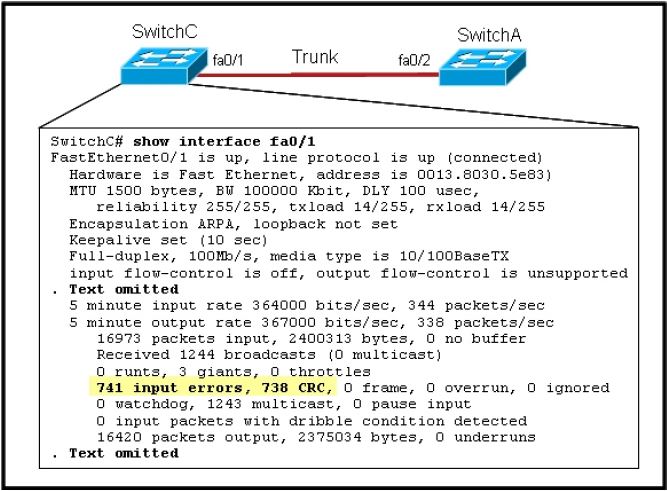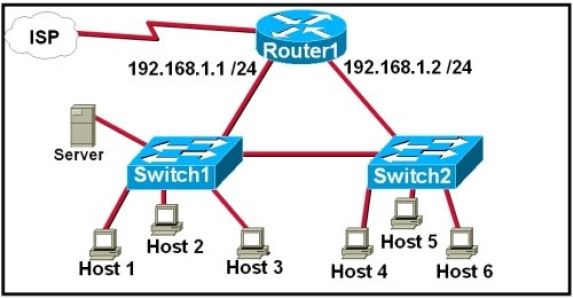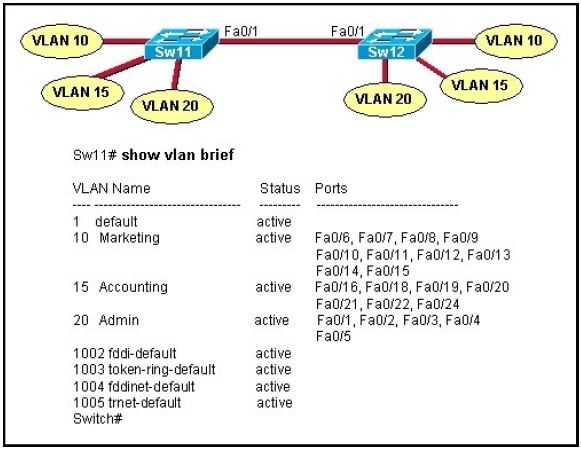Cisco Catalyst switches CAT1 and CAT2 have a connection between them using ports FA0/13. An 802.1Q trunk is configured between the two switches. On CAT1, VLAN 10 is chosen as native, but on CAT2 the native VLAN is not specified.
What will happen in this scenario?
A. 802.1Q giants frames could saturate the link.
B. VLAN 10 on CAT1 and VLAN 1 on CAT2 will send untagged frames.
C. A native VLAN mismatch error message will appear.
D. VLAN 10 on CAT1 and VLAN 1 on CAT2 will send tagged frames.
CISCO CCNA Exam – Q17
Refer to the exhibit.
A network technician is asked to design a small network with redundancy. The exhibit represents this design, with all hosts configured in the same VLAN. What conclusions can be made about this design?
A. This design will function as intended.
B. Spanning-tree will need to be used.
C. The router will not accept the addressing scheme.
D. The connection between switches should be a trunk.
E. The router interfaces must be encapsulated with the 802.1Q protocol.
CISCO CCNA Exam – Q16
Refer to the exhibit.
A technician is troubleshooting host connectivity issues on the switches. The hosts in VLANs 10 and 15 on Sw11 are unable to communicate with hosts in the same VLANs on Sw12. Hosts in the Admin VLAN are able to communicate. The port-to-VLAN assignments are identical on the two switches. What could be the problem?
A. The Fa0/1 port is not operational on one of the switches.
B. The link connecting the switches has not been configured as a trunk.
C. At least one port needs to be configured in VLAN 1 for VLANs 10 and 15 to be able to communicate.
D. Port FastEthernet 0/1 needs to be configured as an access link on both switches.
E. A router is required for hosts on SW11 in VLANs 10 and 15 to communicate with hosts in the same VLAN on Sw12.
CISCO CCNA Exam – Q15
Refer to the exhibit.

Given this output for Switch C, what should the network administrator’s next action be?
A. Check the trunk encapsulation mode for Switch C’s fa0/1 port.
B. Check the duplex mode for Switch C’s fa0/1 port.
C. Check the duplex mode for Switch A’s fa0/2 port.
D. Check the trunk encapsulation mode for Switch A’s fa0/2 port.
CISCO CCNA Exam – Q14
A network administrator is configuring an EtherChannel between SW1 and SW2. The SW1 configuration is shown. What is the correct configuration for SW2?
A.
interface FastEthernet 0/1
channel-group 1 mode active
switchport trunk encapsulation dot1q
switchport mode trunk
interface FastEthernet 0/2
channel-group 1 mode active
switchport trunk encapsulation dot1q
switchport mode trunk
B.
interface FastEthernet 0/1
channel-group 2 mode auto
switchport trunk encapsulation dot1q
switchport mode trunk
interface FastEthernet 0/2
channel-group 2 mode auto
switchport trunk encapsulation dot1q
switchport mode trunk
C.
interface FastEthernet 0/1
channel-group 1 mode desirable
switchport trunk encapsulation dot1q
switchport mode trunk
interface FastEthernet 0/2
channel-group 1 mode desirable
switchport trunk encapsulation dot1q
switchport mode trunk
D.
interface FastEthernet 0/1
channel-group 1 mode passive
switchport trunk encapsulation dot1q
switchport mode trunk
interface FastEthernet 0/2
channel-group 1 mode passive
switchport trunk encapsulation dot1q
switchport mode trunk
CISCO CCNA Exam – Q13
What parameter can be different on ports within an EtherChannel?
A. speed
B. DTP negotiation settings
C. trunk encapsulation
D. duplex
CISCO CCNA Exam – Q12
Refer to the exhibit.

What set of commands was configured on interface Fa0/3 to produce the given output?
A.
interface FastEthernet 0/3
channel-group 1 mode desirable
switchport trunk encapsulation dot1q
switchport mode trunk
B.
interface FastEthernet 0/3
channel-group 2 mode passive
switchport trunk encapsulation dot1q
switchport mode trunk
C.
interface FastEthernet 0/3
channel-group 2 mode active
switchport trunk encapsulation dot1q
switchport mode trunk
D.
interface FastEthernet 0/3
channel-group 2 mode on
switchport trunk encapsulation dot1q
switchport mode trunk
CISCO CCNA Exam – Q11
You are working in a data center environment and are assigned the address range 10.188.31.0/23. You are asked to develop an IP addressing plan to allow the maximum number of subnets with as many as 30 hosts each. Which IP address range meets these requirements?
A. 10.188.31.0/26
B. 10.188.31.0/25
C. 10.188.31.0/28
D. 10.188.31.0/27
E. 10.188.31.0/29
CISCO CCNA Exam – Q10
What are three features of the IPv6 protocol? (Choose three.)
A. optional IPsec
B. autoconfiguration
C. no broadcasts
D. complicated header
E. plug-and-play
F. checksums
CISCO CCNA Exam – Q9
Which command enables IPv6 forwarding on a Cisco router?
A. ipv6 local
B. ipv6 host
C. ipv6 unicast-routing
D. ipv6 neighbor


